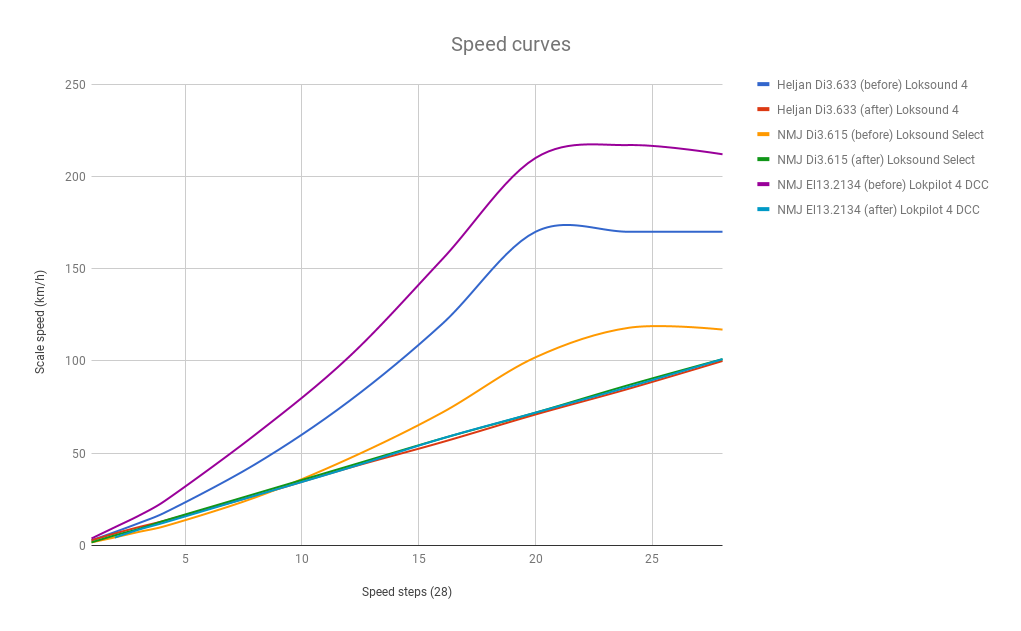Why scale speed?
Operating my layout in a realistic way is important to me. The speed of the trains is one important aspect. By default many locomotives run too fast. To avoid running trains too fast and also to allow them to be running together in a consist I wanted to adjust the max speed that my locomotives can run. I decided to set the max speed to be 100 scale km/h. Most of the Norwegian locomotives, like the Di3, El11 and El13 had a maximum speed that is close to this. And 100 scale km/h is still pretty fast.
Speed curves
DCC decoders provide two ways to adjust the speed curve and therefore its speed over the complete throttle range. The basic adjustments are using a three point system. CV2 allows for starting speed adjustments, CV5 for the top speed and CV6 for a mid point adjustment. A more comprehensive way is the speed curve, where there are 28 CV's (67-94) that allow fine tuning the speed adjustments for speed step.
For most of the adjustments that I've done the basic adjustments were sufficient.
The default speed curve for both Zimo and ESU is not linear. I've changed that to be more linear.
Speed matching
I setup a basic oval with an Accutrack II Speedometer. Then I measured the speed at various throttle positions. The graph show three examples of locomotives before and after adjustments.
As seen in the graph all the three locomotives ran must faster than the 100 scale km/h. The Heljan Di3.633 ran 170 km/h at speed step 28. All three topped out at their max speed at an early speed speed. Therefore the complete throttle range is not used, which is something I don't like.
With the CV changes as seen in the table, all three locomotives were adjusted to the linear speed curve, and now all have a max scale speed of 100 km.h.
| Model | CV2 | CV5 | CV6 |
|---|---|---|---|
| ESU default | 3 | 255 | 88 |
| Heljan Di3.633 | 1 | 90 | 45 |
| NMJ Di3.615 | 1 | 150 | 75 |
| NMJ El13.2134 | 1 | 165 | 82 |
Enter the new Loksound 5 family
| Model | Decoder | CV2 | CV3 | CV4 | CV5 | CV6 |
|---|---|---|---|---|---|---|
| NMJ Di3.620 | Loksound v4.0 | 3 | 125 | 255 | 120 | 60 |
| NMJ Di3.621 | Loksound 5 | 3 | 125 | 255 | 145 | not supported |
| Heljan Di3.641 | Loksound 5 DCC | 1 | 35 | 255 | 245 | 123 |
| NMJ Di3.630 | Loksound 5 | 1 | 35 | 255 | 255 | 128 |
- The Loksound v4 and Loksound 5 all use a momentum multipler of 0.25
- The Loksound 5 DCC uses the NMRA Standard momentum multipler of 0.896.
- The Loksound 5 doesn't support the 3 point speed table (hence no CV6)

